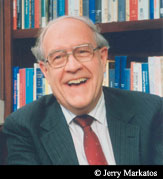The shelf life of software development books is typically two or three years, maybe five or ten years for a “classic.” Frederick Brooks, however, wrote a book on software development in 1975 that remains a best-seller: The Mythical Man-Month. His book has remained popular because he wrote about human nature as applied to software development, not the hottest APIs and development fads from the 1970’s.
Frederick Brooks has written a new book that should also enjoy exceptional shelf life, The Design of Design: Essays from a Computer Scientist (ISBN 0201362988). In this book, Brooks looks back over a long successful career in computing and makes insightful observations about design.
The following interview comes from an email exchange with Frederick Brooks.
JC: You did a PhD in math with Howard Aiken in 1956. Did you study numerical analysis? Did you intend at the time to have a career in computing?
FB: Oh, yes indeed. That’s why I went to Aiken’s lab for graduate work.
JC: I was struck by your comments on conceptual integrity, particularly this quote: “Most great works have been made by one mind. The exceptions have been made by two minds.” Could you say more about that?
FB: I give lots of examples in the book of the one mind case, and a few of the two-mind case.
JC: You said in your book that your best management decision was sending E. J. Codd to get his PhD. That certainly paid off well. Could you share similar examples of successful long-term investments?
FB: Well, IBM’s decision to gamble everything on the System/360, terminating six successful product lines to do so, is a great example. DARPA’s funding of the development of the ARPAnet, ancestor to the Internet, is another great example.
JC: What are some technologies from decades ago that are being rediscovered?
FB: I find it useful to write first drafts of serious things, such as scientific papers and books, by hand with a felt-tip pen. I can type faster than I can think, so composing on a keyboard yields unnecessary wordiness. Writing by hand matches my thinking and writing speeds, and the result is leaner and cleaner.
JC: What are some that have not become popular again but that you think should be reconsidered?
FB: Probably the previous example answers this question better than it does the previous question.
JC: Apart from technological changes, how have you seen the workplace change over your career?
FB: I’ve been in academia for the past 46 years. The biggest change in academia is a consequence of personal computers and networks: faculty members don’t use secretaries as such, they write their own letters, and make their own phone calls. Our assistants are indeed administrative assistants, rather than secretaries.
JC: What change would you like to see happen as a result of people reading your new book?
FB: Even more recognition of the role of a chief designer, separate from a project manager, in making a new artifact, and more attention to choosing and growing such.
* * *
Update: Three years after this interview, I had a chance to meet Fred Brooks in person at the Heidelberg Laureate Forum.
Related links:
Other interviews:


I’m intrigued by the concept of a Chief Designer. Has anyone worked at a place with any corresponding role?
John, have you?
Would we call it Software Architect at bigco? Is that the “corporatized” version of the concept that he’s discussing?
Dan: Here are some the projects that come to my mind when Brooks talks about chief designers: Donald Knuth (TeX), Larry Wall (Perl), Guido van Rossum (Python).
Guido van Rossum is particularly relevant since he is affectionately known by the Python community as the “Benevolent Dictator for Life.”
Hey thanks! I guess I need to read the book – sounds like his ideas are a heck of a lot bigger than how code monkeys get herded :-).